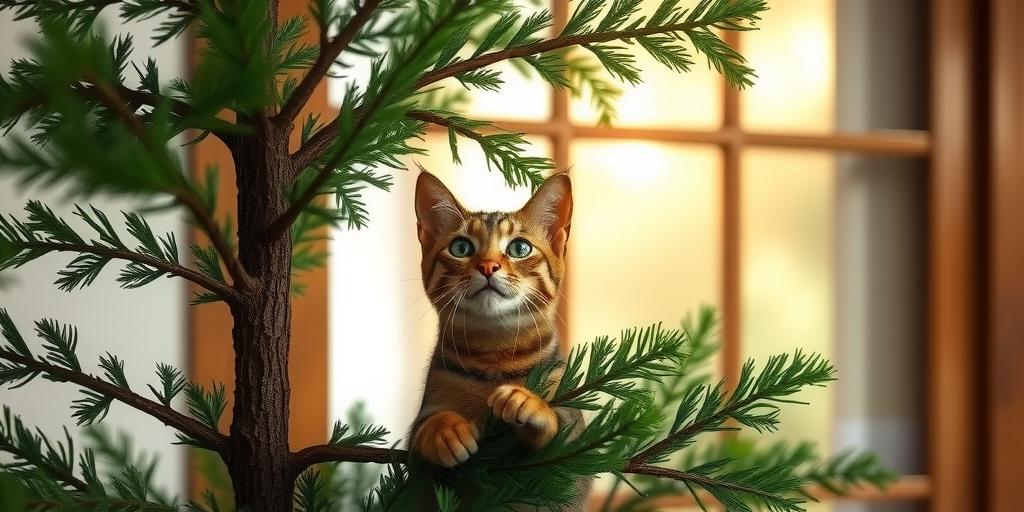
Cat-Safe, Low-Light Indoor Trees: How to Choose & Care for Them (2025 Guide)
Looking for cat-safe, low-light indoor trees? Discover the best pet-friendly plants that thrive in dim spaces and learn expert care tips to keep them lush and safe for your feline friends!
Introduction
Did you know that over 30% of houseplants are toxic to cats? If you’re a plant-loving pet parent, finding the right indoor trees that are both safe for cats and thrive in low light can be tricky. But don’t worry—we’ve got you covered! Whether you live in a shady apartment or just want to spruce up a dim corner, this guide will help you choose the best cat-friendly, low-light trees and keep them thriving. Let’s dive in!
Why Choose Cat-Safe, Low-Light Indoor Trees?
The Dangers of Toxic Plants for Cats
Many common houseplants can be harmful—or even deadly—to cats. Lilies, for example, are highly toxic and can cause kidney failure, while plants like pothos and philodendrons contain calcium oxalate crystals that irritate a cat’s mouth and digestive tract. Symptoms of poisoning include vomiting, drooling, lethargy, and difficulty breathing. If you suspect your cat has nibbled on a toxic plant, contact your vet immediately. Choosing cat-safe plants eliminates this risk, giving you peace of mind while keeping your feline friend safe.
Benefits of Indoor Trees
Beyond being pet-friendly, indoor trees offer several advantages. They act as natural air purifiers, removing toxins like formaldehyde and benzene from your home. Aesthetically, they add life and texture to any space, making rooms feel more inviting. Studies also suggest that indoor plants can reduce stress and improve mood—something both you and your cat can benefit from!
Why Low-Light Plants Are Ideal for Homes
Not every home gets abundant sunlight, especially in apartments or rooms with small windows. Low-light plants thrive in indirect or filtered light, making them perfect for spaces that don’t get full sun exposure. They’re also generally hardier and require less maintenance, which is great for busy pet owners.
Top 5 Cat-Safe Indoor Trees That Thrive in Low Light
1. Parlor Palm (Chamaedorea elegans)
The Parlor Palm is a classic choice—non-toxic, elegant, and surprisingly low-maintenance. Its feathery fronds add a tropical touch without demanding much sunlight. Water it when the top inch of soil feels dry, and it’ll happily grow in medium to low light. Plus, it’s safe even if your curious cat takes a nibble.
2. Money Tree (Pachira aquatica)
Known for its braided trunk and lush foliage, the Money Tree is pet-safe and thought to bring good fortune. It adapts well to low-light conditions, though it prefers bright, indirect light if possible. Keep the soil slightly moist but not soggy, and rotate the plant occasionally for even growth.
3. Spider Plant (Chlorophytum comosum)
Spider Plants are practically indestructible—perfect for forgetful plant parents. They thrive in low to moderate light and produce cascading baby plants (or “spiderettes”) that look great in hanging baskets. Best of all, they’re completely safe for cats, though some felines may be tempted to bat at the long leaves!
4. Calathea (Prayer Plant)
With its striking, patterned leaves, the Calathea adds a pop of color to dim corners. It’s non-toxic to cats and prefers shade, making it ideal for low-light spaces. Keep the soil consistently moist (but not waterlogged) and mist the leaves occasionally to maintain humidity.
5. Bamboo Palm (Chamaedorea seifrizii)
If you want a larger statement plant, the Bamboo Palm is an excellent pick. It’s safe for cats and excels at purifying the air. While it prefers bright, indirect light, it can tolerate lower light levels. Water when the topsoil feels dry, and wipe the leaves occasionally to keep them dust-free.
How to Care for Low-Light, Cat-Safe Trees
Light Requirements
Low-light doesn’t mean no light. Most of these plants still need some indirect sunlight—placing them near a north-facing window or a few feet away from a brighter spot works well. If your space is particularly dark, consider supplementing with a grow light for a few hours a day.
Watering Tips
Overwatering is the quickest way to kill a low-light plant. Since these plants grow slower in dim conditions, they need less frequent watering. Always check the soil before watering—stick your finger an inch deep; if it’s dry, it’s time to water. Ensure your pots have drainage holes to prevent root rot.
Soil & Potting
A well-draining potting mix is key. Look for blends containing perlite or orchid bark to improve aeration. Repotting every 1-2 years helps refresh the soil and gives roots room to grow.
Pruning & Maintenance
Remove yellow or dead leaves regularly to keep your plant healthy. Wipe dust off leaves with a damp cloth to ensure they can absorb light efficiently. For bushier growth, pinch back new growth on plants like the Spider Plant.
Pet-Proofing Your Plants
Even non-toxic plants can be tempting for cats to chew or dig in. To deter them, try placing citrus peels or aluminum foil around the base of the plant. You can also provide cat grass as a safe alternative for them to nibble on.
Common Mistakes to Avoid
Overwatering Low-Light Plants
Since these plants grow slower in low light, they don’t absorb water as quickly. Overwatering leads to root rot—a common killer of indoor plants. Always err on the side of underwatering.
Placing Plants in Complete Darkness
No plant can survive in a pitch-black room. If your space has zero natural light, opt for artificial lighting or choose faux plants instead.
Ignoring Signs of Plant Toxicity in Cats
Even with cat-safe plants, monitor your pet’s behavior. If they’re excessively chewing on leaves (even non-toxic ones), it could lead to stomach upset. Redirect their attention with cat-friendly greens.
Using Unsafe Fertilizers or Pesticides
Some plant treatments contain chemicals harmful to pets. Always opt for organic, pet-safe fertilizers and avoid pesticides unless they’re explicitly labeled as non-toxic for animals.
Conclusion
Choosing cat-safe, low-light indoor trees doesn’t have to be complicated! With the right picks—like Parlor Palms, Money Trees, and Bamboo Palms—you can create a lush, pet-friendly oasis even in the shadiest corners. Remember to monitor your plants and cats, provide proper care, and enjoy a greener, safer home. Ready to transform your space? Start planting today!
